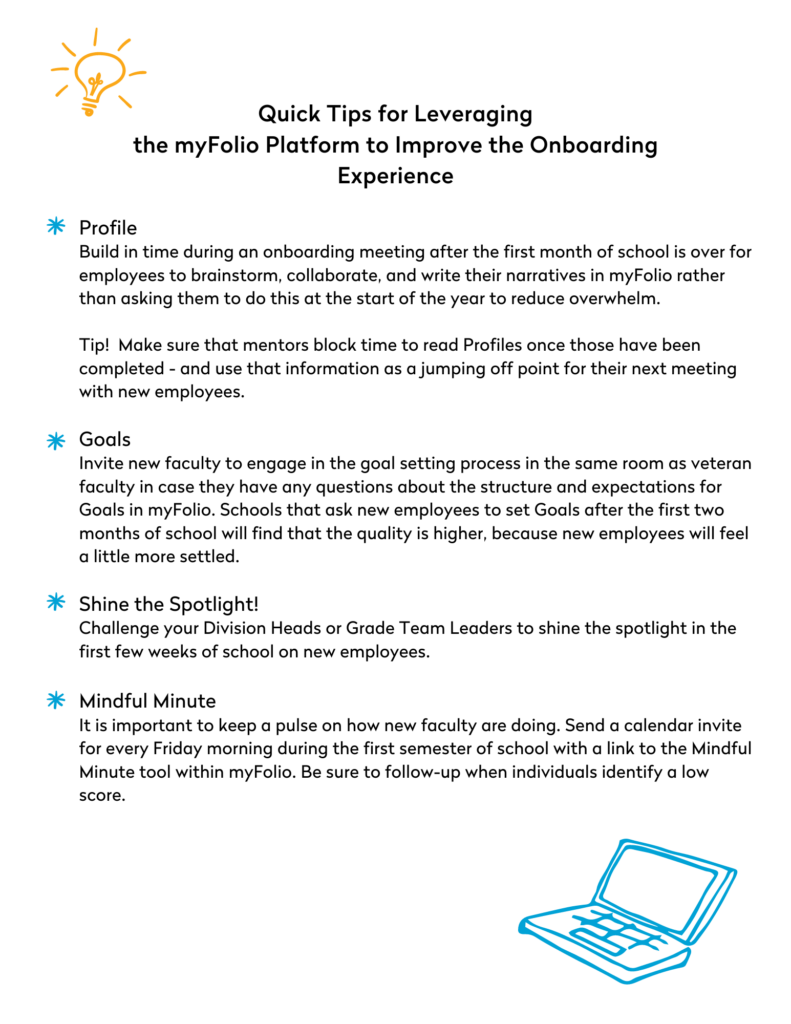By Michael Russell & Meredith Monk Ford
This past February, I had the opportunity to present at the National Association of Independent Schools (NAIS) annual conference with five fellow members of last year’s Aspiring Heads Fellowship [1], sharing our findings about how independent schools view their current onboarding processes. It should come as no surprise that most of the 263 schools surveyed reported that an effective onboarding process is essential to the success and retention of new employees. It was also clear that a majority of schools felt their programs overwhelmed new hires with information and lacked important support for essential job expectations, school culture acclimation, and opportunities for feedback. Schools want to do better, and as leaders look toward the summer months, now is a good time to consider how your school can better prepare for welcoming new hires onto campuses and into your communities.
Onboarding begins from the moment of hire
The onboarding process begins the moment a new hire signs their letter of employment to join your school, and it is not uncommon for some to sign their employment agreements well in advance of their official start date. During this time, schools can kickstart their onboarding process by using a proactive, concierge-style approach. Composed of regularly scheduled check-ins customized to the needs of the employee, as well as an intentionally paced distribution of informational materials, this ‘pre-boarding’ process serves to ensure that new employees feel as comfortable as possible when they arrive for their first day of work.
Rethinking Summer Orientation – Slow Drip versus Fire Hose
Summer onboarding, often culminating in a new employee orientation, is an overwhelming experience for many new hires due to the deluge of operational, administrative, and procedural information they are asked to process in a short period of time. Schools need to be thoughtful about what information is essential to share with their new hires and in what format. Much of what is shared during new employee orientation may best be distributed via a “New Employee Survival Guide” given to new hires shortly after they have accepted their offer, providing them with more time to process important details about the school’s culture, calendar, and operations leading up to the start of the school year.
Two focus areas of onboarding
The onboarding process can be considered through two lenses: onboarding a person into a role, and onboarding a person into a school. For many schools, the focus is placed squarely on the former during the first weeks of employment. New employees review their job descriptions and performance expectations, receive introductory training with essential IT, and go over school policies and procedures. Once this phase is completed, there often is a hard transition to the latter focus, integrating into school culture. This process runs contrary to how many of our schools otherwise operate. Opening days of school launch with school traditions, celebratory events, the start of the fall athletics season, and more. Similarly, procedural concerns such as mid-mark grades and comments, student discipline processes, or formal classroom observations, do not take place until the school year is well underway. In an effort to help new employees feel as if they belong and address their needs in a timely manner, schools would benefit from taking a holistic approach to onboarding that aligns with the timely needs of the annual calendar.
How Folio Can Help:
Managing new employees using a myFolio Workspace helps you organize and track the steps needed to successfully transition new employees into your school. Workspaces can exist independently from the all-school milestone timeline, and they can span school cycles. A single Workspace can be used for employees for the full 14+ month onboarding process that begins when they sign their contract.
Consider creating a Workspace for new faculty and assign a member of the leadership team to oversee this cohort, as the Workspace Leader. This person will be able to set Waypoints and track the progress of all new employees in one central place. Encourage members of the new cohort of employees to share helpful resources and preload the Workspace with all of those important onboarding documents and links, so that they’re easy for people to locate.
Using myFolio for onboarding (from Folio’s Onboarding Playbook):
Additional resources for onboarding new faculty and staff including onboarding planning calendar, sample slide decks, and suggested meeting agendas are included in Folio’s Onboarding Playbook.
[1] – I am indebted to my team members from the Aspiring Heads Fellowship and the work we did collaboratively to study onboarding, transition, and integration practices – much of which informed the insights shared in this article: Jared Givarz, Middle School Head at Burgundy Farm Country Day School; Stacy Jagodowski, Director of Strategic Marketing and Communications at Tabor Academy; MJ Jones, Assistant Head of School at University Liggett School; Anthony Perry, Director of Diversity, Equity and Inclusion at The Lab School; and Debbie Witmer, STEM Department Chair at Church Farm School.


